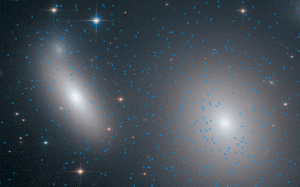Key takeways
- NGC 1277, a galaxy in the Perseid cluster, has remained unchanged since its formation 10 billion years ago, offering a rare glimpse into the early universe.
- The galaxy’s star clusters are mostly red, indicating it hasn’t merged with other galaxies over time. This sets it apart from the Milky Way, which has both red and blue clusters from past mergers.
- NGC 1277 provides a unique opportunity to study the nature of ancient galaxies, as it is in a state of “arrested development” and is relatively close at 240 million light years away.
- Despite being smaller than the Milky Way, NGC 1277 has twice as many stars and moves too quickly, at two million miles per hour, to merge with other galaxies in the cluster.
- Scientists have identified ten more potential remnant galaxies and plan to use the James Webb Space Telescope to study them further, including their globular clusters and dark matter content.
Galaxy NGC 1277 is shown to be a remnant galaxy that has not altered since its formation 10 billion years ago, providing astronomers with a unique glimpse into the past.
Michael Beasley and Ignacio Trujillo of Instituto de Astrofísica de Canarias proposed using the Hubble Space Telescope to observe a “relic galaxy” that has remained mostly unaltered since its formation. Such immaculate exemplars of the distant past are very rare, accounting for just roughly one out of every thousand galaxies. The two felt they had a strong contender in the Perseid cluster’s NGC 1277, and they were correct.

How the artifact was discovered
The scientists were warned off by the relative redness of NGC 1277’s globular clusters, which are groupings of stars. These usually come in two hues. Red globular clusters develop at the beginning of a galaxy, are closer to its core, and contain larger quantities of helium. Blue globular clusters are remnants of minor galaxies that have been swallowed by a bigger one throughout time. The lack of blue clusters in NGC 1277 shows that it has stayed mostly unaltered since its formation. Our Milky Way is a combination of red and blue globular clusters caused by our continual cannibalization of other galaxies as we travel through space.

A huge glance into the past
Despite the fact that NGC 1277 is 10 billion years old, it provides astronomers with an exceptional chance to learn more about the nature of newborn galaxies. NASA describes the galaxy as being in a condition of “arrested development.” “I’ve been studying globular clusters in galaxies for a long time, and this is the first time I’ve ever seen this,” Beasley says, adding that “this is the first time a galaxy so massive has been observed with so few blue globular clusters.” It’s also quite close—about 240 million light years away—making it an even more significant discovery. “We can explore such original galaxies in full detail and probe the conditions of the early universe,” declares Trujillo.
Just in the neighborhood
NGC 1277 is located in the Perseid cluster, which includes over a thousand galaxies, some of which are undoubtedly smaller than NGC 1277; nevertheless, astronomers believe that NGC 1277 is just moving too rapidly at two million miles per hour to absorb any galaxies it passes through. It’s just about a fifth the size of our own galaxy, but it contains twice as many stars, so there’s enough to look at.
Beasley and Trujillo discovered ten more probable remnant galaxies in addition to NGC 1277. With the launch of the James Webb Space Telescope in 2019, they want to gain a better look at their discovery and follow how its globular clusters migrate. They also expect to be able to determine how much dark matter the galaxy contains.


